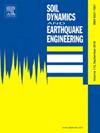Axial-flexure-shear model for seismic analysis of RC thin-walled hollow piers
IF 4.2
2区 工程技术
Q1 ENGINEERING, GEOLOGICAL
引用次数: 0
Abstract
Reinforced concrete (RC) thin-walled hollow piers often exhibit prominent flexure-shear effect, especially when subjected to pulse-like earthquakes. To predict the axial-flexure-shear behaviors of such hollow piers, an innovative approach named Axial-Flexure-Shear-Interaction-Membrane-Beam-Truss-Element-Model (AFSI-MBTEM) is developed. In the AFSI-MBTEM, the RC hollow pier is discretized into membrane elements, beam elements, and truss elements. The bi-scalar damage-plasticity concrete model is used in the membrane elements to consider the compression-softening effect and the degradations of strength and stiffness. Concrete01 and ReinforcingSteel are adopted as uniaxial materials for beam-column elements and truss elements. The axial-flexure and axial-shear behaviors are coupled through the multi-dimensional material and the integration of multiple element types. The numerical approximation of the AFSI-MBTEM for rectangular and circular RC hollow piers is presented, and it is implemented in OpenSees. A series of RC thin-walled hollow piers with different failure modes under cyclic loading were collected for validation. The predictions against experimental results indicate that the AFSI-MBTEM captures the cyclic responses of RC hollow piers with excellent accuracy, convergence, and efficiency. However, overestimations of yield plateau and energy dissipation, along with sudden drops at large ductility, are observed in simulations using the flexure model. The dynamic responses of the full-scale hollow piers under 223 pulse-like motions further demonstrate the superiority of the AFSI-MBTEM. Meanwhile, the flexure model underestimates their dynamic responses due to the enhanced energy dissipation capacity and the neglect of shear effects.
钢筋混凝土薄壁空心桥墩抗震分析的轴向弯剪模型
钢筋混凝土(RC)薄壁空心桥墩往往表现出突出的弯剪效应,特别是在脉动地震作用下。为了预测这种空心桥墩的轴向弯剪性能,提出了一种新颖的轴向弯剪相互作用-膜-梁-桁架-单元模型(AFSI-MBTEM)。在AFSI-MBTEM中,钢筋混凝土空心墩被离散为膜单元、梁单元和桁架单元。膜单元采用双标量损伤塑性模型,考虑了压缩软化效应和强度刚度退化。梁柱单元和桁架单元采用混凝土和钢筋作为单轴材料。通过材料的多维度和多单元类型的集成,实现了轴向弯曲和轴向剪切的耦合。提出了矩形和圆形混凝土空心桥墩的AFSI-MBTEM数值逼近方法,并在OpenSees中实现。收集了一系列循环荷载作用下不同破坏模式的RC薄壁空心墩进行验证。与试验结果的对比表明,AFSI-MBTEM对RC空心桥墩的循环响应具有较好的准确性、收敛性和效率。然而,在使用挠曲模型的模拟中,可以观察到屈服平台和能量耗散的高估,以及大延性下的突然下降。全尺寸空心墩在223次脉冲运动下的动力响应进一步证明了AFSI-MBTEM的优越性。同时,由于耗能能力的增强和剪切效应的忽略,挠曲模型低估了它们的动力响应。
本文章由计算机程序翻译,如有差异,请以英文原文为准。
求助全文
约1分钟内获得全文
求助全文
来源期刊

Soil Dynamics and Earthquake Engineering
工程技术-地球科学综合
CiteScore
7.50
自引率
15.00%
发文量
446
审稿时长
8 months
期刊介绍:
The journal aims to encourage and enhance the role of mechanics and other disciplines as they relate to earthquake engineering by providing opportunities for the publication of the work of applied mathematicians, engineers and other applied scientists involved in solving problems closely related to the field of earthquake engineering and geotechnical earthquake engineering.
Emphasis is placed on new concepts and techniques, but case histories will also be published if they enhance the presentation and understanding of new technical concepts.
 求助内容:
求助内容: 应助结果提醒方式:
应助结果提醒方式:


